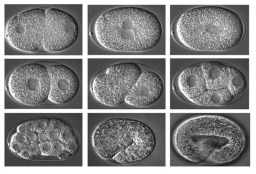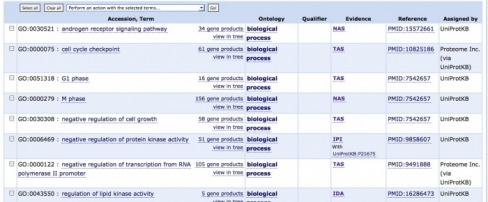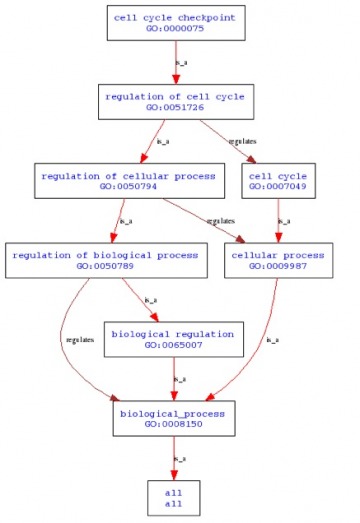This web page was produced as an assignment for Genetics 677, an undergraduate course at UW-Madison
RNAi Studies: C. elegans retinoblastoma protein ortholog Lin35

Lin35 is the RB1 ortholog to the human RB1 gene. Lin35 functions redundantly with class A genes to antagonize Ras signaling. Additionally, and more importantly, Lin35 functions redundantly with several other genes in larval development, where it is expressed broadly, and fertility.
Fig 1: Embryonic development of
the nematode C. elegans within
the eggshell.
The experiment that identified Lin35 was a study of the genes necessary for proper development of C. elegans. Researchers used RNAi to knock out specific genes to test what their developmental role is. Videos of the development of embryos from this experiment can be found listed below, under references.
Videos
Video 1
Video 2
Video 3
Gene Ontology

The above image are the results of a gene ontology search. Clicking on the picture will take you to the AmiGo website with the search results for RB1. The search yields 15 results for RB1. The majority of the results are for biological processes involved in cellular growth and cell cycle checkpoints, which makes sense given that RB1 is an oncogene. So a disabling mutation in RB1 will lead to the loss of ability to regulate cell cycle checkpoints and lead to cancerous cellular behavior. In addition, results also implicate RB1 in cell components and molecular functions.
The RB1 protein is a negative regulator of the cell cycle. Additionally, the protein also stabilizes constitutive heterochromatin to maintain overall chromatin structure.
The active RB1 protein binds to the transcription factor E2F1. Defects in this gene are also a cause of bladder cancer and osteogenic sarcoma, in addition to retinoblastoma.
Below is a graphical view of one the cell cycle controls related to RB1. Clicking on the picture will take you to the Gene Ontology page showing the cell cycle diagram.
References
1. RNAi Database Entry on Lin35, http://nematoda.bio.nyu.edu:8001/cgi-bin/browse/card.rnai.cgi?query=Cenix:13-a9
2. B Sonnichsen, et al. (2005) Full-genome RNAi profiling of early embryogenesis in Caenorhabditis elegans. http://www.ncbi.nlm.nih.gov/pubmed/15791247?dopt=Abstract
3. Video 1: http://worm-srv2.mpi-cbg.de/ceimages/13/13-a9-1-d1-1.mov
4. Video 2: http://worm-srv2.mpi-cbg.de/ceimages/13/13-a9-1-d2-2.mov
5. Video 3: http://worm-srv2.mpi-cbg.de/ceimages/13/13-a9-1-d3-3.mov
6. Fig 1: Embryonic development of the nematode C. elegans with the eggshell. http://www.apsnet.org/education/feature/Celegans/Images/fig6.htm
7. NCBI, http://www.ncbi.nlm.nih.gov/protein/108773787?report=genpept&log$=seqview#comment_108773787

